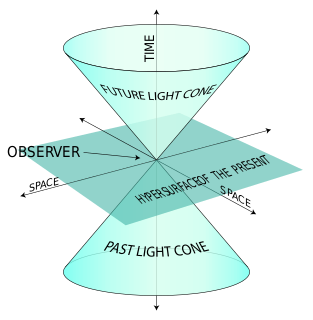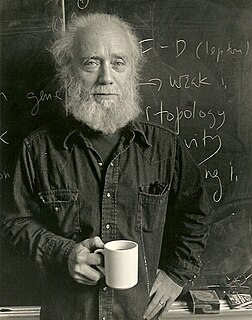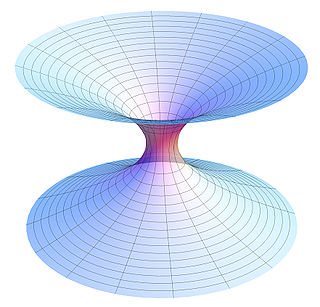Related Research Articles

General relativity, also known as the general theory of relativity and Einstein's theory of gravity, is the geometric theory of gravitation published by Albert Einstein in 1915 and is the current description of gravitation in modern physics. General relativity generalizes special relativity and refines Newton's law of universal gravitation, providing a unified description of gravity as a geometric property of space and time or four-dimensional spacetime. In particular, the curvature of spacetime is directly related to the energy and momentum of whatever matter and radiation are present. The relation is specified by the Einstein field equations, a system of second order partial differential equations.
Quantum gravity (QG) is a field of theoretical physics that seeks to describe gravity according to the principles of quantum mechanics, and where quantum effects cannot be ignored, such as in the vicinity of black holes or similar compact astrophysical objects, and where the effects of gravity are strong, such as neutron stars.

In physics, the special theory of relativity, or special relativity for short, is a scientific theory regarding the relationship between space and time. In Albert Einstein's original treatment, the theory is based on two postulates:
- The laws of physics are invariant in all inertial frames of reference.
- The speed of light in vacuum is the same for all observers, regardless of the motion of the light source or observer.

The theory of relativity usually encompasses two interrelated theories by Albert Einstein: special relativity and general relativity, proposed and published in 1905 and 1915, respectively. Special relativity applies to all physical phenomena in the absence of gravity. General relativity explains the law of gravitation and its relation to other forces of nature. It applies to the cosmological and astrophysical realm, including astronomy.
In physics and chemistry, the law of conservation of energy states that the total energy of an isolated system remains constant; it is said to be conserved over time. This law, first proposed and tested by Émilie du Châtelet, means that energy can neither be created nor destroyed; rather, it can only be transformed or transferred from one form to another. For instance, chemical energy is converted to kinetic energy when a stick of dynamite explodes. If one adds up all forms of energy that were released in the explosion, such as the kinetic energy and potential energy of the pieces, as well as heat and sound, one will get the exact decrease of chemical energy in the combustion of the dynamite.

The Large Scale Structure of Space–Time is a 1973 treatise on the theoretical physics of spacetime by the physicist Stephen Hawking and the mathematician George Ellis. It is intended for specialists in general relativity rather than newcomers.

In physics, the principle of relativity is the requirement that the equations describing the laws of physics have the same form in all admissible frames of reference.
In theoretical physics, particularly in discussions of gravitation theories, Mach's principle is the name given by Einstein to an imprecise hypothesis often credited to the physicist and philosopher Ernst Mach. The hypothesis attempted to explain how rotating objects, such as gyroscopes and spinning celestial bodies, maintain a frame of reference.

Scientific laws or laws of science are statements, based on repeated experiments or observations, that describe or predict a range of natural phenomena. The term law has diverse usage in many cases across all fields of natural science. Laws are developed from data and can be further developed through mathematics; in all cases they are directly or indirectly based on empirical evidence. It is generally understood that they implicitly reflect, though they do not explicitly assert, causal relationships fundamental to reality, and are discovered rather than invented.

John Archibald Wheeler was an American theoretical physicist. He was largely responsible for reviving interest in general relativity in the United States after World War II. Wheeler also worked with Niels Bohr in explaining the basic principles behind nuclear fission. Together with Gregory Breit, Wheeler developed the concept of the Breit–Wheeler process. He is best known for popularizing the term "black hole," as to objects with gravitational collapse already predicted during the early 20th century, for inventing the terms "quantum foam", "neutron moderator", "wormhole" and "it from bit", and for hypothesizing the "one-electron universe".
In particle physics, the baryon number is a strictly conserved additive quantum number of a system. It is defined as
Quantum foam is a theoretical quantum fluctuation of spacetime on very small scales due to quantum mechanics. Matter and antimatter are constantly created and destroyed. These subatomic objects are called virtual particles. The idea was devised by John Wheeler in 1955.

In physics, mass–energy equivalence is the relationship between mass and energy in a system's rest frame, where the two values differ only by a constant and the units of measurement. The principle is described by the physicist Albert Einstein's famous formula: .
In theoretical physics, general covariance, also known as diffeomorphism covariance or general invariance, consists of the invariance of the form of physical laws under arbitrary differentiable coordinate transformations. The essential idea is that coordinates do not exist a priori in nature, but are only artifices used in describing nature, and hence should play no role in the formulation of fundamental physical laws. While this concept is exhibited by general relativity, which describes the dynamics of spacetime, one should not expect it to hold in less fundamental theories. For matter fields taken to exist independently of the background, it is almost never the case that their equations of motion will take the same form in curved space that they do in flat space.

Absolute space and time is a concept in physics and philosophy about the properties of the universe. In physics, absolute space and time may be a preferred frame.

David Ritz Finkelstein was an emeritus professor of physics at the Georgia Institute of Technology.
Retrocausality, or backwards causation, is a concept of cause and effect in which an effect precedes its cause in time and so a later event affects an earlier one. In quantum physics, the distinction between cause and effect is not made at the most fundamental level and so time-symmetric systems can be viewed as causal or retrocausal. Philosophical considerations of time travel often address the same issues as retrocausality, as do treatments of the subject in fiction, but the two phenomena are distinct.

Theoretical physics is a branch of physics that employs mathematical models and abstractions of physical objects and systems to rationalize, explain and predict natural phenomena. This is in contrast to experimental physics, which uses experimental tools to probe these phenomena.

Physics is a scientific discipline that seeks to construct and experimentally test theories of the physical universe. These theories vary in their scope and can be organized into several distinct branches, which are outlined in this article.
Arthur B. Komar was a theoretical physicist, specializing in general relativity and the search for quantum gravity. Arthur Komar made a significant contribution to physics as an educator, research scientist, and administrator. He had wide interests in numerous other subjects.
References
- ↑ John Wheeler - Principle of mutability (Part 2) (89/130), October 6, 2017, archived from the original on 2021-12-12
- ↑ John Archibald Wheeler (1973), "From Relativity to Mutability", The Physicist’s Conception of Nature, pp. 202–247, doi:10.1007/978-94-010-2602-4_9, ISBN 978-94-010-2604-8
- ↑ Richard A. Matzner (2010), General Relativity and John Archibald Wheeler, Springer Science & Business Media, p. 34, ISBN 9789048137350
- ↑ Kip S. Thorne, ed. (October 28, 1985), "John Archibald Wheeler: A Few Highlights of His Contributions to Physics", Between Quantum and Cosmos, p. 9